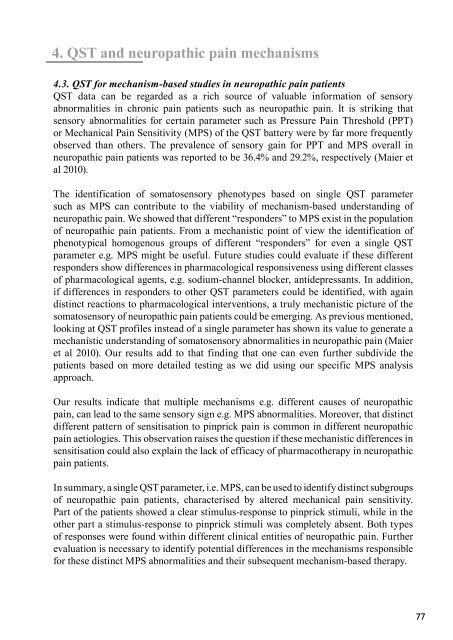Quantitative Sensory Testing (QST) - Does assessing ... - TI Pharma
Quantitative Sensory Testing (QST) - Does assessing ... - TI Pharma
Quantitative Sensory Testing (QST) - Does assessing ... - TI Pharma
You also want an ePaper? Increase the reach of your titles
YUMPU automatically turns print PDFs into web optimized ePapers that Google loves.
4. <strong>QST</strong> and neuropathic pain mechanisms<br />
4.3. <strong>QST</strong> for mechanism-based studies in neuropathic pain patients<br />
<strong>QST</strong> data can be regarded as a rich source of valuable information of sensory<br />
abnormalities in chronic pain patients such as neuropathic pain. It is striking that<br />
sensory abnormalities for certain parameter such as Pressure Pain Threshold (PPT)<br />
or Mechanical Pain Sensitivity (MPS) of the <strong>QST</strong> battery were by far more frequently<br />
observed than others. The prevalence of sensory gain for PPT and MPS overall in<br />
neuropathic pain patients was reported to be 36.4% and 29.2%, respectively (Maier et<br />
al 2010).<br />
The identification of somatosensory phenotypes based on single <strong>QST</strong> parameter<br />
such as MPS can contribute to the viability of mechanism-based understanding of<br />
neuropathic pain. We showed that different “responders” to MPS exist in the population<br />
of neuropathic pain patients. From a mechanistic point of view the identification of<br />
phenotypical homogenous groups of different “responders” for even a single <strong>QST</strong><br />
parameter e.g. MPS might be useful. Future studies could evaluate if these different<br />
responders show differences in pharmacological responsiveness using different classes<br />
of pharmacological agents, e.g. sodium-channel blocker, antidepressants. In addition,<br />
if differences in responders to other <strong>QST</strong> parameters could be identified, with again<br />
distinct reactions to pharmacological interventions, a truly mechanistic picture of the<br />
somatosensory of neuropathic pain patients could be emerging. As previous mentioned,<br />
looking at <strong>QST</strong> profiles instead of a single parameter has shown its value to generate a<br />
mechanistic understanding of somatosensory abnormalities in neuropathic pain (Maier<br />
et al 2010). Our results add to that finding that one can even further subdivide the<br />
patients based on more detailed testing as we did using our specific MPS analysis<br />
approach.<br />
Our results indicate that multiple mechanisms e.g. different causes of neuropathic<br />
pain, can lead to the same sensory sign e.g. MPS abnormalities. Moreover, that distinct<br />
different pattern of sensitisation to pinprick pain is common in different neuropathic<br />
pain aetiologies. This observation raises the question if these mechanistic differences in<br />
sensitisation could also explain the lack of efficacy of pharmacotherapy in neuropathic<br />
pain patients.<br />
In summary, a single <strong>QST</strong> parameter, i.e. MPS, can be used to identify distinct subgroups<br />
of neuropathic pain patients, characterised by altered mechanical pain sensitivity.<br />
Part of the patients showed a clear stimulus-response to pinprick stimuli, while in the<br />
other part a stimulus-response to pinprick stimuli was completely absent. Both types<br />
of responses were found within different clinical entities of neuropathic pain. Further<br />
evaluation is necessary to identify potential differences in the mechanisms responsible<br />
for these distinct MPS abnormalities and their subsequent mechanism-based therapy.













